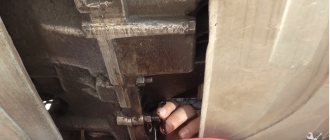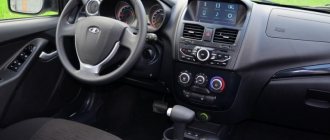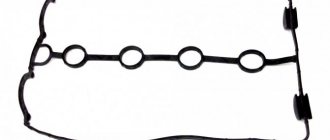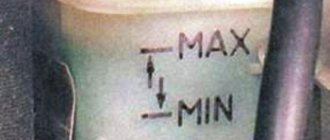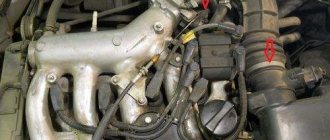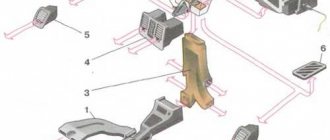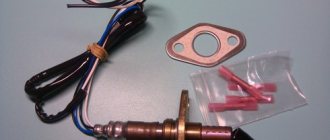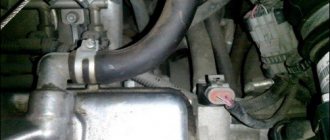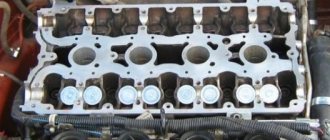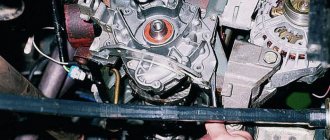History of creation
The VAZ 2112 hatchback model was produced since 1999, becoming the successor to the 2110 sedan and 2111 station wagon. The “Twelfth” became a close analogue of the famous tenth model, but had a slightly shortened body. As planned by the manufacturers, the 2112 was supposed to combine all the advantages of the “ten” and “eleven”, so the five-door hatchback was chosen as the body type.
VAZ-2112 Pre-production (1994)
The 12th model began to be mass produced in 2000; it lasted 8 years on the assembly line. Unlike the sedan and station wagon of the tenth series, the assembly of the “dvenashka” was not transferred to the Ukrainian ones.
Although the twelfth model was positioned as an improved “ten”, the improvements here are very conditional and not always obvious. Therefore, the difference between these two models is not too big. AvtoVAZ designers continued to look for new solutions, as a result of which other lines and modifications appeared, which also have both their pros and cons.
Repair and maintenance of the power unit
A specific case of repair work is given as an example. Repair of the VAZ 2112 engine was required for several reasons: you have to constantly add antifreeze, the lubrication indicator blinks, and the hydraulic compensators click. We preliminarily carried out a compression measurement, which showed a difference in the cylinders of up to two atmospheres.
During the disassembly process, the causes of the malfunction were identified:
- burnout of the cylinder head gasket, as a result of which antifreeze went into one of the cylinders;
- corrosion of the cylinder head mating plane;
- wear of the crankshaft main journal liners;
- wear of exhaust valve guides;
- sintering of the insides of the catalytic collector.
Description of engine restoration procedures:
- milling the head plane and the mating plane of the block;
- repressing exhaust valve guides;
- mechanical processing (without lapping) of valve seats;
Installation of new parts:
- pistons of size group C (instead of the original B);
- piston rings;
- crankshaft bearings and thrust half-rings;
- oil seals and gaskets;
- cooling pump;
- valve stem seals;
- metal cylinder head gasket from Priora;
- toothed belt complete with tension roller from Power Grip;
- INA hydraulic pushers;
- NGK spark plugs;
- “spider” 4-1 made of stainless steel;
People often ask: what kind of oil to pour into a VAZ 2112? In the described case, after assembly, Lukoil Lux 10W40 engine oil was filled in.
Exterior
Looking at the “twelve”, it immediately becomes clear that its prototype was the “ten”. Externally, these two cars are very similar, it is immediately clear that they belong to the same family: the same rounded, smooth lines and roundness of the body, the same heaviness, especially in the rear of the car. Of course, whether you like the design of the car is a matter of taste. Many note that the twelfth model is the most beautiful of the entire line.
Lada 2112 (1999–2008)
It is also noticeable that the designers tried to give the car some sportiness by adding a rather large spoiler to the trunk door, rounding the body as much as possible and replacing the thirteen-inch “tens” wheels with 14 inches. However, despite all the developers’ tricks, it’s quite difficult to call the 12th Lada sports. Changes also affected the roof of the car. Here it is more sloping, making the car look more interesting. The body length of the 2112 model is slightly shorter than that of the “ten”.
If we compare the car with the 11th model, then the rear door is noticeably larger, which can be opened both from the outside using the key and from inside the cabin by pressing the corresponding button. But the fifth door opens only if you pull it on the plastic spoiler, which does not have a positive effect on it.
Lada 2112 (1999–2008)
The trunk, like the hood, boasts gas struts. It is convenient to load, the volume is 400 liters. The shelf in the trunk rattles and knocks a lot when driving. You can get into the car through the trunk door if all other doors are blocked or jammed.
Car engine, its types
The heart of the car, its main component, is the engine. It is this part of the car that creates torque, which is transmitted to the wheels, causing the car to move in space. Today there are the following main types of car engines:
- ICE or internal combustion engine, which uses the energy of the fuel burned in its cylinders to produce mechanical energy;
- an electric motor powered by electrical energy from batteries or hydrogen cells (cars powered by hydrogen cells today are already available from most leading automakers as prototypes and are even in small-scale production);
- hybrid engines that combine an electric motor and an internal combustion engine in one unit, the connecting link between which is a generator.
It is a complex of mechanisms that convert the thermal energy of the fuel burning in its cylinders into mechanical energy. By type of fuel burned, all internal combustion engines are divided into the following types:
- gasoline;
- diesel;
- gas;
- hydrogen, in which the fuel is liquid hydrogen (installed only on experimental models).
According to the design of internal combustion engines there are:
Interior
The interior of the car is simple and not very presentable. You won’t find any “bourgeois excesses” here. The only exception is electric windows and heated front seats, but this is not found in all modifications of the car.
The steering wheel is large and very antediluvian. The steering column is height adjustable only. Moreover, some models come without power steering and electric power steering, which is a significant disadvantage.
Torpedo Lada 2112 (2006-08)
To the right of the steering wheel is a console with a heater, radio, on-board computer (if equipped) and main keys. The heater, in theory, should be adjustable in order to separately heat the windows, top and bottom of the cabin, but in reality everything is heated at once. There are no airbags in the cabin.
The glove compartment is quite large and even has a backlight. The position of the exterior mirrors is adjusted by a special lever, but it is adjusted very mediocrely, so usually no one uses it.
A tall person is unlikely to be comfortable in the back row of seats, because his head will touch the ceiling. Long-legged people will also not be very comfortable, since there is quite a bit of space left to the front seats. The width of the cabin is cramped; only two passengers can be comfortably accommodated. Three people will fit, but they will be cramped.
Interior of Lada 2112 (1999–2008)
The rear windows are manual and constantly stick. As anyone who has ever owned a Lada, Zhiguli or any other AvtoVAZ product knows, the windows go down exactly to the level they want. Often it is completely impossible to lower the glass completely; it gets stuck in the middle and does not move anymore.
The rear row seats recline together or separately, which increases the size of the trunk, so you can put a fairly large load in the car.
Body parts
The VAZ 2112 is popular among novice motorists. This is precisely what can explain certain shortcomings and deformations that appear on the car body elements over time. A novice driver is usually inexperienced and makes certain mistakes that lead to accidents or breakdowns.
Note. Bumpers suffer more often than others. These body elements are damaged during sudden braking or when the start is not timely enough, which leads to impacts from the front and rear.
Car wings are no less susceptible to deformation. These parts themselves are not very strong, and if they collide in a serious accident, they are severely deformed. Less serious damage can be corrected, according to the dimensions given by the standard geometry of the VAZ 2112 body. Complex deformations cannot be restored, and it is easier to replace.
Note. The front wings of the VAZ 2112 suffer most often, since these are the parts that break during side front impacts when the “twelve” does not give way.
And, of course, corrosion eats up a lot of parts of the VAZ 2112 if the owner does not take sufficient care of the vehicle. The hood, doors and those parts of the body that are either hidden from view or located close to the road surface are most often exposed to the negative effects of rye.
Engine modifications
Under the hood of Lada 2112 (1999–2008)
In total, there are 6 engine modifications for the VAZ 2112:
- 21120 – the basic version of the 1.5 liter internal combustion engine. The disadvantage is the presence of free space inside the cylinder head and the block itself.
- 21124 – increased power (up to 89 hp) and increased engine capacity (up to 1.6 liters).
- 21126 – power increased to 98 hp. with an engine capacity of 1.6 liters.
- 21127 – the volume is still 1.6 liters, but the power is increased to 106 hp.
- 21128 – power is 105 horses, which is achieved by increasing the volume of the combustion chamber (1.8 liters). The problem with the valves bending has been resolved.
- 21129 – the engine has a volume of 1.8 liters, a phase shifter has been added.
Vehicle clearance (ground clearance)
Due to large rims and a special suspension design, the vehicle's ground clearance is 210 mm without load. These characteristics are enough to successfully overcome various obstacles that often appear on the way in the city or on light off-road conditions.
Thanks to this ground clearance, the crossover can easily pass through high hatches without the risk of damaging the bottom. The special shape of the bottom of the car, which hides all the parts and components of the chassis, deserves special attention.
Options
Lada 112 Coupe (2002–06)
The car was produced in several versions:
- 21120 – basic version with a 16-valve 1.5-liter engine with multipoint injection. Equipped with 14-inch wheels. Engine power – 93 hp.
- 2112i – version with fuel injection system.
- 21120 GLI (Gran Luxury Injector) – luxury version of the car.
- 21121 – modification with an engine capacity of 1.6 liters. Power – 81 hp
- 21122 – simplified, budget option. It was produced without electric windows, with 13-inch wheels and brakes from the VAZ 2108.
- 21123 Coupe - a three-door version, the so-called “coupe”, although in fact it is an ordinary three-door hatchback. It was assembled individually and in limited edition. The coupe's body is more rigid, as is the suspension. Handling is better than the standard version. The car was expensive, produced in 2002-2006.
- 21124 – injection version with a 1.6-liter engine. By increasing the depth of the groove in the piston crown, the creators managed to solve the problem of valve bending, which plagues the standard version.
- 21128 – modification with a 1.8-liter engine. Power – 105 hp.
- 2112-37 – racing version with a 1.5 liter engine, equipped with a roll cage.
- 2112-90 “Tarzan” – version with all-wheel drive. A Niva engine (1.7 and 1.8 liters) was installed.
Getting to know the “twelve”
ATTENTION! A completely simple way to reduce fuel consumption has been found! Don't believe me? An auto mechanic with 15 years of experience also didn’t believe it until he tried it. And now he saves 35,000 rubles a year on gasoline!
The VAZ 2112 or “two-piece” car was produced, like its analogues, at the Volzhsky Automobile Plant. It is a 5-door hatchback body, reminiscent of the VAZ 2110 sedan in shape.
Production of the “twelve” began in the 99th year of the last century. The car body was copied from the VAZ 2110, but shortened to 4170 mm. The volume of the luggage compartment is 400 liters. Due to the shortening of the body, the car, compared to the “ten”, began to respond better to turning the steering wheel.
And in general, the model has a sportier character than the VAZ 2110. Combining all the advantages of the “ten”, the VAZ 2112 is also equipped with the rear seat of the 2111 station wagon.
The clear improvements over previous models are as follows:
- Despite the small length of the body, you can increase the small volume of the hatchback by transforming the rear seat;
- Better handling, especially when entering corners.
Like most VAZ models, the “dvenashka” was produced in several modifications and designs. In particular, we note the VAZ 21123 in the coupe body type. This modification even went through 3 body restylings and initially had a unique, original hood and bumper. Subsequently, the model was equipped with a grille and a standard hood.
Body features and the importance of geometric dimensions
In general, the “dvenashka” model is almost the most popular car in the domestic automobile industry, it is cheap and has a good design and a wide variety of body styles.
When developing this model, the manufacturer took into account many factors, including compliance with the individual tastes of each customer. In this regard, several body versions of the VAZ 2112 were produced, each of which had different targets.
Coupe, station wagon, sedan, hatchback - the “two-piece” was equipped with all these body types. The coupe is more correctly called a 3-door hatchback. This is the most rarely seen modification of the VAZ 2112. Its sporty design distinguishes it from other versions of the family, which are generally made quite monotonously.
Body repair VAZ 2112 coupeBody repair VAZ 2112 coupe
Experts believe that the VAZ 2112 coupe has the right to be called the best in terms of body design features and design. In total, about 10 thousand cars of this type were produced, after which production was discontinued.
Dimensions and dimensions also, along with the type of body structure, play a big role in convenience for passengers and good handling. Some modifications of the VAZ 2112 were even equipped with a sunroof, which increases the ease of use of the car.
So, here are the body dimensions of the VAZ 2112:
- Body – hatchback;
- Length, mm – 4170;
- Height, mm – 1435;
- Width without rear view mirrors, mm – 1680;
- Width with rear view mirrors, mm – 1875.
They, as we see from the table, better meet modern requirements and help the machine cope with a greater number of functions. The good spaciousness of the interior and trunk of the “two-wheeler” is a clear confirmation of this. Passengers feel very comfortable inside; the car can carry a lot of cargo if you are planning a long-distance family trip.
Specifications
Visibility
Visibility in the cabin is good, everything is perfectly visible from the driver's seat, the glass area is large. However, the rear view is partially blocked by the spoiler.
Body
The bodies of all Lada cars leave much to be desired. They are made of thin and very low quality metal that rusts instantly. The sills, arches and lower parts of doors are most susceptible to corrosion. If you find a VAZ 2112 in good condition, then both the arches and the sills will probably be overcooked.
Mileage
If you monitor the car and the condition of the engine, then the VAZ 2112 can “run” up to 200-250 thousand, which is not too much. On the other hand, the engine can be rebuilt or a new one installed, because Lada engines are obscenely cheap.
Lada 2112 (1999–2008)
The fuel consumption of the “twelfth” cannot but rejoice. So in urban conditions it consumes 7-9 liters per 100 km. On the highway - 5-6 liters.
Transmission
The 12th model was equipped with a 5-speed manual transmission. It differs from the gearbox on the VAZ 2110 only in name.
Disadvantages of a gearbox on a “two-wheeler”:
- unreliability;
- unclear switching;
- strong howl;
- frequent wear of the synchronizer, accompanied by crackling and noise when changing gears;
- oil leaks through seals, breather and gaskets;
- knockout of the gear or refusal to engage due to wear of the bushings;
- failure of bearings and gears after 100 thousand mileage.
Suspension
The front suspension of the VAZ 2112 is independent, the rear suspension is dependent. The problem with all LADA cars is CV joints and bearings that quickly fail. The struts also quickly begin to leak, the springs rust. The quality of spare parts generally leaves much to be desired, including new ones. Owners complain that some elements have to be replaced several times, because new parts arrive already defective or break in the first months of operation.
Body geometry and its diagnostics
How much does an 8 valve engine on a VAZ 2110 weigh?
The most important components of body geometry are called control points. It is the knowledge of their location and the ability to correctly measure the distances between them that determines the structure of checking the body for deformation. You can learn more about control points from the technical documentation for each car model.
After identifying damage, the integrity of the body is usually restored in special workshops. Experienced straighteners bring the body back to normal in the shortest possible time, if only the deformations are of moderate or minor severity. A body that has been in a serious accident and has received a lot of deformation is usually easier to replace with a new one.
What deformations can occur on the VAZ 2110?
The “Ten” involved in the accident will have certain deviations from the standard positions marked at the factory. And destruction in this case means the following:
- Deviations in terms of the standard wheel arrangement, as evidenced by poor vehicle stability and increased tire wear;
- The diagonals, again, standardly installed at the factory, are violated. Doorways, pillars and other areas of the body, one way or another, associated with the impact zone are especially often affected.
In most cases, the destruction of functional elements is associated with the appearance of folds in the floor or other components of the body. In addition, external impacts cause a significant increase in the part in areas far from the point of impact.
Several ways to check the body for deformation
You can determine the deformation of a body that has been in a moderate accident at first glance. On the contrary, if the blow was weak, then it can be extremely difficult to determine the damage by eye. In this case, you have to carefully carry out diagnostics, measure compliance, and so on.
A hydraulic jack helps to carry out an initial inspection of the car. Thanks to the lift, you can examine the condition of the floor, feel those parts of the body that are inaccessible for inspection with the normal position of the car, for the presence of folds. After detecting the latter, as a rule, they are marked with a marker, which makes it possible to easily find deformed areas during subsequent stages of work.
If such a check does not give any results, proceed to the next stage of the examination, which involves checking the wheels. It is no longer a jack, but a special stand that helps carry out the check. Using such equipment, it is easy and faster to carry out the second stage of diagnostics. Check the front and rear wheels of the car at control points using calipers with a special profile shape.
Checking the compliance of the control points of the “shoes” of the car involves verification (comparing) the wheel coordinates located on one side of the car with the coordinates on the other side. Body deformation becomes obvious if measurements show significant deviations from specified standards.
Another method of diagnosing damage to the “tens” body is to compare the diagonals. The exact coordinates of the main diagonals are given in the table below. This diagnosis is considered the most correct, since it is carried out using a symmetry check.
Modern technologies allow this to be done using various tools. A computer on which appropriate measurements are carried out helps a lot in this matter. The option of checking using template tools and mechanical measurements is also used.
As a rule, at home on a VAZ 2110 you can remove the geometric dimensions of the body yourself using a standard tape measure. But at the service station, a special telescopic ruler is already used for the same purpose, which gives more accurate results.
But both of these measurement methods have a significant drawback. Thus, they do not make it possible to measure spatial deformations. The latter can only be diagnosed using template or computer methods. This will give a complete picture of the deformations, which will allow the damage to be eliminated most effectively. Although, the price of such a check will be many times higher.
The car body is an intricate and complex structure that has a number of values required for normal operation. Their violation causes significant deviations, the configuration of the entire body changes. By measuring the geometry of the body, the car owner has the opportunity to detect even the most minor defects, which can lead to big problems in the future.
Brake system
Front brakes are disc, rear brakes are drum. Although the brakes on the “two-wheeler” are quite mediocre and ineffective, owners most often do not complain about them, because repairs cost a small amount. The brake pedal is usually a little stiff, but the braking distance is acceptable.
Lada 2112 (1999–2008)
We will enter the remaining technical characteristics into the table.
| Parameter | Index |
| Body shape | hatchback (5 doors), coupe (3 doors) |
| Engine volume, l | 1.5, 1.6, 1.8 |
| Length, mm | 4170 |
| Width, mm | 1680 |
| Height, mm | 1420 |
| Wheelbase, mm | 2492 |
| Ground clearance, mm | 160 |
| type of drive | front |
| Gearbox type | 5-speed manual |
| Weight, kg | 1495 |
| Trunk volume, l | 400 |
| Fuel tank volume, l | 43 |
| Fuel type | petrol |
Vehicle dimensions and wheelbase
The crossover belongs to class C (according to the European classification).
- The total length of the machine is 4545 mm.
- The wheelbase of the crossover is within 2721 mm.
- The total height of the car is 1565 mm.
- The width of the Arcana is 1820 mm, excluding side mirrors.
The listed characteristics are optimal for a city car, which will allow the owner to comfortably occupy parking spaces or move around in confined spaces.
The total width of the body with mirrors is 2047 mm. If necessary, the mirrors can be folded, which will provide additional centimeters for tight parking. The wheelbase of 2.72 m is quite large.
For a car of this level, such parameters allow you to achieve the necessary smoothness in the city. On light off-road conditions, the wheelbase with relatively short overhangs will be enough to overcome minor obstacles without damaging the body.
Controllability
It would seem that the reduced base (when compared with the “ten”) should have made the car more obedient, but for some reason everything is different with the “two”. Handling here is very mediocre. When turning, you often have to fight with the steering wheel, which constantly strives to return to its original position. There are cars without power steering, the driving of which gives little pleasure, and the steering wheel seems to be filled with lead and generally refuses to rotate adequately.
Lada 2112 (1999–2008)
When cornering, the body often begins to sway and roll to the side, causing the wheels to lose traction on the asphalt. This happens especially often on rough roads. It is better not to accelerate too much in the VAZ 2112, because at high speeds you can easily lose control.
Characteristics and features of the body
The general body characteristics of this model stand out from other 2021 cars. Renault Arcana is based on new developments that were created from scratch.
Dimensions:
4545 x 1820 x 1565
Weight, kg:
1370
The manufacturer uses an innovative body on a new generation SUV module. More than 55% of the components in the chassis are completely new. Moreover, the remaining 45% are parts that have already been tested by time on different Renault models.
High-strength steel parts are highlighted in blue.
A well-designed body contributes to a more correct distribution of weight along the axles. Thanks to this feature, the crossover has good handling and sensitivity when cornering.
Together with additional electronic systems, the machine feels confident on any type of surface. The modular design of the model forms a protected capsule for passengers. During testing, the car scored fairly high safety scores.
Competitors
Fiat Albea
Fiat Albea (2002–05)
The Fiat Albea is a reliable four-door sedan, very cheap and unpretentious. On the secondary market you can find versions with an engine capacity of 1.4 and 1.6 liters. Albea's body is galvanized, so there are cars with whole metal. This option is perfect for city driving. If you are considering buying a VAZ 2112 specifically for city driving, then the Fiat Albea will be an excellent replacement. Comfort, like any foreign car, will be higher than that of the Lada, there is air conditioning. The build quality is also higher, the sound insulation is satisfactory.
LADA 2114
Lada Samara 2114 (2001–13)
VAZ 2114 is the older sister of the “twelfth”, which is also not intended for high-speed driving and has very mediocre handling. This is a great option for fishing trips. The car, due to its lighter weight, drives perfectly through the fields, it can be rocked and pulled out of any large puddle or hole.
The “fourteenth” does not have a hydraulic booster, but the steering wheel nevertheless rotates well. The 14 is lighter, making it easier to ride off-road, but the lighter weight means less stability on the trail. In strong winds and on sharp turns, the car easily lifts off the ground.
This car, like the 12th model, is suitable for beginners and young people who do not have money for a more expensive and high-quality car.
ZAZ Chance
ZAZ Chance Hatchback (2009–14)
This is another representative of the ultra-budget segment. Like all other domestically produced machines, it is characterized by low quality and low cost. Its interior is a little more comfortable and visually pleasing than that of the VAZ.
How much does the VAZ weigh?
Perhaps one of the most popular cars in the post-Soviet space was, is and remains the VAZ. This car has captivated many generations. However, how did it all begin? When was the first VAZ car produced and how much did it weigh? You will learn the answers to these and other questions from this article.
The first VAZ car was produced by the Volzhsky Automobile Plant on April 19, 1970. The make of this car was VAZ-2101 Zhiguli. Its production was carried out according to the analogue of the Fiat concern. Moreover, VAZ owes its appearance to this particular brand of Fiat 124, produced in 1966. Here, in fact, is it:
As a result of some design improvements, the first domestic car, the VAZ 2101 of 1970, was produced:
The weight of this car was 955 kg. Moreover, of this mass the engine weighed 114 kg.
It has not lost its popularity to this day. In 2000, it was recognized as the best car among eighty thousand car enthusiasts surveyed in the CIS countries and Russia. It was named the best car of the century, VAZ 2101. At the time of its production, it was considered the most comfortable, reliable and modern domestic car. Its presence was a sign of wealth and prosperity!
But the Volzhsky Automobile Plant did not stop there. He created entire collections of this car. Each of them differed in its configuration, as well as its total weight. Therefore, now we will compare some VAZ models by their weight.
- VAZ 2102 has a weight of 1010 kg .
- VAZ 2103 has a weight of 965 kg .
- VAZ 2104 has a weight of 1020 kg .
- VAZ 2105 has a weight of 1060 kg .
- VAZ 2106 has a weight of 1045 kg .
- VAZ 2107 weighs 1049 kg .
- VAZ 2108 weighs 945 kg .
- VAZ 2109 weighs 915 kg .
- VAZ 2110 has a weight of 1020 kg .
- VAZ 2111 has a weight of 1055 kg .
- VAZ 2112 has a weight of 1060 kg .
- VAZ 2113 weighs 975 kg .
- VAZ 2114 weighs 985 kg .
- VAZ 2115 has a weight of 1000 kg .
- VAZ 2116 weighs 1276 kg .
- VAZ 2117 has a weight of 1110 kg .
- VAZ 2118 has a weight of 1110 kg .
- VAZ 2119 has a weight of 1110 kg .
- VAZ 2120 has a weight of 1110 kg .
- VAZ 2121 has a weight of 1550 kg .
- VAZ 2122 has a weight of 1122 kg .
- VAZ 2123 has a weight of 1300 kg .
But this is the total weight of a VAZ car. As for some parts of the car, the weight of, for example, a VAZ 2106 can be decomposed as follows:
- The weight of the engine with equipment is 140 kilograms .
- The weight of the gearbox is 26 kilograms .
- The weight of the square shaft is 10 kilograms .
- The weight of the rear axle is 52 kilograms .
- Radiator weight – 7 kilograms .
- Body weight – 280 kilograms .
It will be useful: Why the VAZ-2114 turn signals do not work and repairs
On average, the weight of all components of a VAZ car has approximately the same mass. Throughout the entire period of existence of this car, quite interesting facts have been recorded that simply cannot be ignored. It’s hard to imagine that a car weighing an average of 1 ton is very popular.
So, the VAZ 2121 Niva car is not only the most popular throughout the USSR, but also the most exported. Just imagine, this model was produced in 1.8 million cars. And of this amount, 500,000 were sold to more than 100 countries. As we remember, the weight of the VAZ 2121 is 1550 kilograms . This means that over the entire period, 775,000,000 kilograms of this car were sold! Also, this particular model of all Soviet cars was driven in Japan. As for the design of the VAZ 2108, it was developed by the currently well-known company Porshe. Its engine weighs 127.3 kilograms . This became necessary due to the fact that the demand for this brand of car was greatly reduced. For this reason, they decided to modernize it.
Moreover, the VAZ car became more popular because the Lada car was the first car of the famous Formula 1 racer - Kimi Raikkonen. His father loved this car extremely much for its reliability.
So, we learned that each VAZ car model has its own separate weight. But throughout the history of its existence and production, it has not undergone major changes.
Advantages and disadvantages
The main advantage of the Lada, as mentioned earlier, is its low cost. Spare parts can be found everywhere. Even in small towns there are car services with domestic spare parts. Repairs are very cheap.
The remaining pros and cons of the VAZ 2112 are listed in the table for convenience.
| pros | Minuses |
| Cheapness and availability of spare parts | Rapidly rotting body metal |
| Large trunk, expanding due to the rear seats | Low ceilings in the cabin, which is inconvenient for tall people, the cabin is cramped |
| Maneuverability in urban environments | Poor handling |
| Low gasoline consumption, economical | Low quality plastic |
| Powerful stove | Lack of vibration and noise insulation in the cabin |
| Good forward visibility | Low quality of elements and spare parts, frequent breakdowns |
| Nice glass headlights | No airbags |
| Low road tax | No air conditioning |
| Passability on broken and rural roads | Rear view suffers due to protruding spoiler |
| Nice appearance | No power steering |
| Possibility of tuning and restyling | Valve bending when timing belt breaks |
Pros and cons of the twelfth model
The duality of the design concept led to the fact that the Lada 12 was never the only five-door hatchback in the production program of the Tolyatti plant. The AvtoVAZ hatchback VAZ 2112 rolled off the assembly line from 1999 to 2008. It shared its place on the assembly line with other five-door cars in the same body:
- from 1999 to 2001, Lada 12 and VAZ 2109 were produced in parallel;
- from 2001 to 2004, VAZ 2112, VAZ 2109 and VAZ 2114 were released simultaneously;
- from 2004 to 2008, model 12 was produced in parallel with the VAZ 2114.
The features of the target audience of the 12th fret are very poorly read, in contrast to alternative models. Buyers of the VAZ 2109 represented a large army of staunch supporters of the most popular domestic car of the 90s - the “nine”, glorified in songs. The fourteenth model that appeared later also had many fans. A light face lift only benefited the car. New headlights and the design of the front end refreshed the appearance of the car; it became noticeably more modern, which the market liked.
The Lada 12 had little to offer in this competitive competition. The electronic fuel injection engine control system offered few advantages because the first twelfth models entered the market with a carburetor version of the engine. When injection versions of the Lada 12 appeared, competitors were not slow to repeat this move. All that remained was a more than dubious attempt to follow the ideas of biodesign that was fashionable at that time. Such tuning of the VAZ 112 did not give serious success, because:
- the ideas themselves were 15 years out of date by the time the car appeared;
- they were implemented very clumsily.
In terms of technical parameters, models 2112 and 2114 are very similar. VAZ 2112 is 4 centimeters longer than its brother in the production line. For comparing cars of the same layout, the volume of a cube is great, into which you can fit a car with specific dimensions. This parameter is in the case of model 2114 4122 mm x 1650 mm x 1402 mm = 3817 cubic meters. dm. And for 2112 - 4170 mm x 1680 mm x 1435 mm = 4050 cubic meters. dm. The difference is 5.7%. In terms of total weight, the cars (1410 and 1495 kg, respectively) differ by 5.6%.
But the trunk of the VAZ 2114 is significantly smaller - 330 liters versus 399. Additionally, in Lada 12 you can free up another 330 liters for luggage by folding the rear seats. You can fold them partially - the back is divided in a ratio of 1:2, and the parts fold independently of each other. Car owners note that the interior of the twelfth model is cramped for passengers taller than 180 cm. Common to both cars, car enthusiasts note shortcomings in the operation of the heating system, shortcomings in seat adjustments, as well as a creaky interior.
Chassis and its advantages
On the move, the “two-piece” is akin to a foreign car of those times: soft, smoothly overcoming bumps. The whole feeling is spoiled by the front panel bouncing on the pits.
The clearance of the VAZ-2112 is high even by today's standards. 160 cm along with short overhangs allow you to easily climb curbs and easily drive through large holes without touching the bottom. When fully loaded, due to the design, the rear wheels begin to “shuffle” against the arches.
Disadvantages of VAZ-2112
Most used Twelves are sold with corrosion. It covers the rear fenders, the spare wheel well, the sills, the bottom, and the contour of the windshield rubber seal. If the car has not been looked after, there may be corrosion at the bottom of the doors.
Replacement will cost a decent amount: doors excluding painting - about 9,000 rubles apiece, rear fenders - about 6,000 rubles, a niche for a spare wheel - 1,500 rubles. For painting one element you will have to pay at least 5,000 rubles per element. Even at the slightest hint of rust, run away from the car. It’s better to take a closer look at the well-painted version: it has no corrosion - you won’t have to spend money on repairs.
When buying a 16-valve engine, set aside 6,000 rubles to replace hydraulic compensators (they last no more than 100 thousand km, and if the oil quality is poor, even less), on many cars they knock. The mass air flow sensor often fails. The first signs by which you will know about a breakdown will be increased fuel consumption and high idle speed (replacement - from three thousand rubles).
Also pay attention to the front struts and their supports. The first ones often fail by 30 thousand
kilometers, the tires of the latter begin to peel off (all together will cost from 6,000 rubles).
Another common problem with the VAZ-2112 is non-working rear lights. You will have to either change the board or clean and tighten the contacts. By the way, the rear lights of the “twelve” often fog up, and this, unfortunately, cannot be cured.
Reviews from VAZ 2112 owners
I bought the car in 2009 with a mileage of 86 thousand kilometers. I immediately changed the brake pads, fluids, and filled the engine with oil. Afterwards I had to change the front struts, bearings, ball joints and steering ends. I haven’t repaired the engine, it doesn’t eat my oil, I’ve added about half a liter over the course of a year. I also changed the front brake discs and pads. Among the advantages, I can mention the engine, a pleasant interior, a spacious trunk, good acoustics and a radio. The car drives smoothly, the gears shift clearly, the braking system is adequate, the steering is sensitive (I have power steering).
Andrey, Samara
I drove a car for a year and can refute all the stereotypes about the domestic automobile industry. Gasoline consumption on the highway is 5 liters, in the city - 7-8! Where else will you find this? Over 20 thousand mileage, only the ignition and consumables were changed: timing belt, spark plugs, gaskets, pipes, etc. Sometimes something leaks, but this is a LADA. We are thinking of selling because we want a newer and more comfortable car, but it’s a shame. Cons: there is no sound insulation at all, but my husband and I taped the trunk and all the doors, it became much quieter. My husband is too lazy to glue the panel. If you're wondering whether it's worth taking, then go for it. As a first car, it’s simply super, especially for young people.
Ekaterina, St. Petersburg
VAZ 2112 is an inexpensive and marketable car with good cross-country ability. I took it to go to work, to the dacha, fishing and to the forest to pick mushrooms. It’s absolutely not a pity to break it on our roads. Naturally, there is no suspension, the CV joints are all crunchy, it all needs to be sorted out. The turning radius is large, visibility is also not very good, especially from the rear. Factory wheels bend a lot, although they straighten out easily. The biggest disease is valve bending if the timing belt breaks. Another disadvantage: everything in the cabin creaks and rattles, the rear shelf from the subwoofer shakes and makes terrible sounds. But for this amount of money the car is excellent. No show-offs or bells and whistles, but cheap to maintain and quite unpretentious.
Evgeniy, t. Tver
As for me, if you choose from the Lada model range, then its appearance is the most beautiful. The interior is comfortable, I have a European panel, seats with lateral support. The dynamics are normal. I had power steering included, which is generally nice for a VAZ. The ride is good, the suspension is just right for driving on our rough roads. Naturally, after a foreign car you feel that the handling is not very good, but overall it’s normal. The reviews write that the struts on the VAZ 2112 quickly die, but everything is fine for me, I drove for 45 thousand and didn’t change anything at all, then I sold it. The build quality is, of course, terrible. And something is constantly leaking, either from the box or antifreeze. It’s better to buy a cheap two-wheeler with cheap spare parts than a junked foreign car.
Sergey, Pskov
I can say that for 100 thousand I definitely wouldn’t have bought a better car. “Classics” don’t appeal to me at all. The cross-country ability of the VAZ 2112 was surprising. I drove it to the dacha on broken roads and to pick mushrooms. She coped better than many foreign passenger cars. Maintainability is also excellent. I easily changed everything myself, spending pennies. Spare parts are much cheaper than for foreign cars. The stove heats well, the cabin is warm in winter, but it warms the legs slowly. The rear seats recline comfortably. I carried boxes of tomatoes, potatoes, pumpkins, and a bunch of bags. Of course, there are also disadvantages. Sound insulation is terrible. I glued the doors, it got better, but the noise still remained. Everything shakes and rattles, the plastic is disgusting. The torpedo makes a lot of noise, especially on dirt roads. Handling on the highway is poor. It’s fine in the city, but on the highway it’s really scary to accelerate above a hundred, it’s very unsafe. The low beam headlights are weak.
Anastasia, Minsk
Bare body weight of VAZ 2110
How much does the VAZ 2199 engine weigh?
I took the car for spare parts, I took off everything I could, I wanted to sell it as metal, but there are no scales to weigh the body. If anyone knows, tell me how much the bare body of a VAZ 2110 weighs (without doors, trunk lid, hood, rear and front beams, A-pillars, and fenders) in advance thanks a lot!
Comments 16
330 kg turned out
I also sold it without a roof for 2k, with the price of metal being 6.5r/kg
everywhere? Some of us also have 5. There are also 7, but there the scales are twisted too much))
yes, if you take the current to the city
at a price of 7-8 rubles per kg they give about 2-2.3 k for a bare body. cut into pieces. This makes it easier to transport and weigh
If the body is alive, they can buy a quarter or anyone who needs anything (left glass, roof, rear part), and this is more expensive than scrap metal
It’s a long time and he’s bothering me...
they seem to cost more in pieces)
from a penny entirely without doors and hood - pulled 330 kg, from 10 I don’t know
They accept bodies, don’t listen to anyone, you’ll just have to look where. I personally went there to hand over the metal - there was a gantry crane and scales on a hook, and workers there cut the bodies with a cutter and loaded them into the wagons right away. In small caricatures this may not be accepted, but in general they may require some kind of paper, a passport 100%. I didn’t hand over the body itself, a friend had been carrying a penny for a long time, he didn’t even ask about the weight.
| Model | Curb weight, kg | Permitted maximum weight, kg |
| VAZ-2101 | 955 | 1355 |
| VAZ-2102 | 1010 | 1440 |
| VAZ-2103 | 955 | 1355 |
| VAZ-2104 | 1020 | 1475 |
| VAZ-2105 | 995 | 1395 |
| VAZ-2106 | 1045 | 1445 |
| VAZ-2107 | 1030 | 1430 |
| VAZ-2108 | 900 | 1325 |
| VAZ-2109 | 945 | 1370 |
| VAZ-21099 | 970 | 1395 |
| VAZ-21011 | 955 | 1355 |
| VAZ-2110 | 1010 | 1485 |
| VAZ-21102 | 1020 | 1495 |
| VAZ-21103 | 1040 | 1515 |
| VAZ-2111 | 1040 | 1540 |
| VAZ-21111 | 1030 | 1530 |
| VAZ-21113 | 1060 | 1560 |
| VAZ-2112 | 1040 | 1515 |
| VAZ-21122 | 1020 | 1495 |
| VAZ-2113 | 975 | 1400 |
| VAZ-2114 | 970 | 1395 |
| VAZ-2115 | 985 | 1410 |
| VAZ-2121 | 1210 | 1610 |
| VAZ-2170 Lada Priora | 1088 | 1578 |
| VAZ-2170 Lada Priora station wagon | 1088 | 1593 |
| VAZ-1118 Lada Kalina | 1070 | 1545 |
The curb weight of a vehicle is the weight of a vehicle with standard equipment, various consumables (oil, coolant, etc.), but minus the weight of passengers, driver and luggage.
Dry weight is equal to curb weight, but only without fuel, some equipment and consumables. That is, this is the mass of an unloaded vehicle without fuel.
The permissible gross weight is the weight of the maximum loaded vehicle provided by the manufacturer. This is sometimes called the maximum permissible mass. It is better not to go beyond the limits of this indicator, unless, of course, you want your car to last for a very long time. The increased load has a negative impact on the car body and suspension parts.
Random entries - how much does it weigh:
Domestic cars are always popular among car owners. The main reason is availability in terms of price, as well as inexpensive maintenance. Back in Soviet times, VAZ earned a reputation as a high-quality and reliable car.
True, over time, drivers began to trust VAZ cars less, but this does not apply to older models like 2112 and those that came before it. The VAZ-2112 car began to be produced in the late 90s. And he still enjoys trust.
Tuning
VAZ-2112 is one of the best solutions of the Russian automobile industry.
The car has little comfort. However, many people strive to highlight their vehicle through tuning. Nowadays, tuning has become very popular, especially for domestic cars. Due to the fact that manufacturers have reduced the body size, the hatchback has become more comfortable to drive. Another advantage can be added to the high ability to maneuver during turns, which makes this car look like a sports class car. “Dvenashka” is, on the whole, a complete and comfortable car, but almost every master will find something that needs to be improved. For example, you can update the silhouette of a car. For this, various additions are used that allow you to create a new appearance for the Lada 2112. In addition, experts advise increasing the aerodynamic data of the vehicle.
Appearance tuning
To change the appearance, new body components should be used. Some VAZ-2112 owners resort to a stylish aerodynamic body kit, which can have a different appearance. There is a sporty type, and there is a body kit that emphasizes the unique style and characteristic feature of the Soviet hatchback.
After installing such body kits, the “two-piece” will be a little similar to American cars. There are two types of aerodynamic body kit for such a five-door:
- The first - with a sporty bias - affects the smoothness of control when moving at high speed due to the correct structure;
- The second is one that improves style. The kit includes an impressive air intake, which allows you to easily cool the power unit and braking system.
You can upgrade your car if you work on its lighting. The lighting is installed not only under the bottom itself, but also the lights located at the stern. More modern front optics will help rejuvenate the hatchback, giving it a sporty touch. In this case, LED lighting is used.
On the practical side, you can install a heated windshield, which helps save a lot of time when cleaning the glass in winter. In the warm season, such tuning of the VAZ-2112 helps reduce fogging of the vehicle.
Interior tuning
The interior of the car is the favorite part of the car for tuning enthusiasts. Typically, owners decide to install lighting in the interior. Not everyone likes the standard dashboard lighting. Such work can be carried out by any car owner of a Lada 2112 hatchback. There are craftsmen who replace the ceiling with one similar to that of a Lada Priora.
It fits perfectly as it matches the dimensions. Similar actions are carried out with door trim. To improve the level of comfort, noise insulation work is being carried out. Also, for convenience, new seats with good lateral support, a high-quality music system, etc. are installed.
Tuning the technical part
To modernize the technical characteristics of the twelfth model, it is important to increase the displacement. It is determined based on the stroke diameter and piston
To increase this volume, use a factory version or do-it-yourself improvement. If you choose the second case, you will have to convert the factory stroke, but in this way it will not be possible to significantly increase the volume.
Engine chip tuning is very popular today. There is an economical and original sports version of chip tuning for the VAZ 2112. The sports method includes increasing the dynamic performance of the car in the city. You will have to be prepared for increased fuel consumption.
If your large fuel appetite is a bit daunting, you can switch to gas equipment. The economy option reduces fuel consumption in the city, which is what many people are interested in.
Geometric dimensions of openings
| For body 2111 | For body 2112 | For body 21123 |
| A – long diagonal of the rear side window frame – 780 mm | D - long diagonal of the rear side window frame - 710 mm | And – short diagonal of the front doorway – 1000 mm |
| B - short diagonal of the rear side window frame - 370 mm | E - short diagonal of the rear side window frame - 230 mm | K – long diagonal of the front doorway – 1500 mm |
| B – diagonal of the rear door opening – 1280 mm | F - diagonal of the rear door opening - 1320 mm | M - short diagonal of the rear side window frame - 720 mm |
| D – distance from the middle of the upper beam of the rear door opening to the middle of the lower beam of the opening – 925 mm | Z - distance from the middle of the upper beam of the rear door opening to the middle of the lower beam of the opening - 1050 mm | H - long diagonal of the rear side window frame - 1040 mm |
You can learn more about what the main body dimensions of the VAZ 2112 are from the table above and photo materials. In addition, valuable information about methods for measuring geometric diagonals can be gleaned from other instructions presented on our website.
Design
If we talk about the design itself, then everything is very simple and quite interesting:
- The 2112 engine is based on a four-stroke operating principle with distributor fuel injection.
- All cylinders are arranged in a row, which is very good. Due to this, it is possible to obtain high power and low fuel consumption.
- The power unit has one crankshaft with an overhead camshaft. They allow all cylinders to work without interruption.
- It is also worth noting that the power unit is equipped with a closed-type liquid cooling system. That is, getting to it is not very easy; you will have to disassemble most of the units.
- A small feature of the VAZ 2112 engine includes a combined lubrication system: a special liquid is supplied under pressure and sprayed. This technology makes it possible to lubricate almost all mechanisms and parts of a modern unit. Plus, it will last much longer than other companies.
- VAZ specialists say that they are using a completely new method of honing cylinders.
